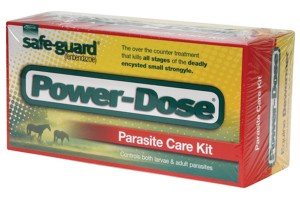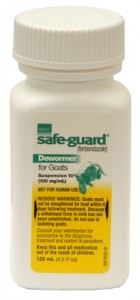 (updated 07-13-10)
(updated 07-13-10)
Planning a safe and effective parasite control program for your horse should include a consultation with a veterinarian. This article is not a substitute for a consultation with a veterinarian.
Safe-Guard dewormer for cattle and goats, which contains 10% fenbendazole in a liquid suspension, can also be used to deworm horses, ponies, mules, and donkeys – both at the single dose rate and at the fenbendazole purge dosage. The fenbendazole or Panacur purge is a double or purge dose of fenbendazole, the active ingredient in Panacur horse dewormer, administered once per day for five days in a row.
The fenbendazole purge deworming regimen for horses specifically targets encysted small strongyles. Small strongyles pose a serious health risk to your horse, and are not affected by most dewormers while in the encysted state.
 The Panacur PowerPac or Safe-Guard Power-Dose is a conveniently bundled package of five syringes, each containing a double dose of fenbendazole paste dewormer for an average size horse. Using Safe-Guard cattle dewormer to administer the fenbendazole purge deworming is roughly half the cost per horse compared to the Panacur PowerPac and Safe-Guard Power-Dose products.
The Panacur PowerPac or Safe-Guard Power-Dose is a conveniently bundled package of five syringes, each containing a double dose of fenbendazole paste dewormer for an average size horse. Using Safe-Guard cattle dewormer to administer the fenbendazole purge deworming is roughly half the cost per horse compared to the Panacur PowerPac and Safe-Guard Power-Dose products.
How much money will I save?
A 1000ml bottle of Safe-Guard cattle dewormer contains enough liquid fenbendazole dewormer to administer the 5-day double-dose fenbendazole purge deworming to four 1000-lb horses, with a cost per horse of about $27 (depending on shipping costs). The Panacur PowerPac or Safe-Guard Power-Dose paste fenbendazole dewormers packaged for horses cost about $50-$60 per horse (prices vary) to administer the fenbendazole purge deworming.
What do I need to buy?
- Safe-Guard dewormer, 10% fenbendazole liquid suspension,
- one gallon bottle (treats sixteen 1000-lb horses),
- 1000ml bottle (treats four 1000-lb horses),
- or two 125ml bottles (treats one 1000-lb horse)
- 60 ml syringe for measuring out the correct dose of dewormer
If you plan to deworm several horses, the gallon and 1000-ml bottles of Safe-Guard cattle dewormer are more economical. If you plan to deworm one horse, two or three 125-ml bottles of Safe-Guard cattle dewormer might be more convenient.

Buy two or three 125ml size Safe-Guard (labeled for use with goats) to purge deworm one horse.
Where can I buy these items?
The 60ml syringe and Safe-Guard cattle dewormer are available from most livestock supply companies.
For example, both items are stocked by Jeffers Livestock Supply at www.jefferslivestock.com
Item# I6-S7 Safe-Guard Cattle Drench, 1 gallon $356.60
Item # I6-S0 Safe-Guard Cattle Drench, 1000 ml $107.45
Item# I6-SK Safe-Guard Goat Dewormer, 125 ml $15.95
Item# S7-B6Â Luer Slip Syringe, 60 ml $1.05
What’s the dosage for an equine?
The cattle dose rate (per pound of body weight) on the Safe-Guard cattle dewormer packaging is the correct dosage for single-dose deworming of horses as well. Double the cattle dosage to get the daily purge dosage for horses. The daily purge dosage for horses is administered once per day for five days in a row. Horses, ponies, mules, and donkeys are all dosed at the same rate per pound of body weight.
Safe-Guard cattle dewormer contains 100mg fenbendazole per ml of liquid.
The normal dose rate for both cattle and horses is:
2.3 mg fenbendazole per lb of body weight, which is equivalent to 2.3 ml Safe-Guard cattle dewormer per 100 lb of body weight
And the fenbendazole purge dose rate is double the normal dose:
4.6 mg fenbendazole per lb of body weight, which is equivalent to 4.6 ml Safe-Guard cattle dewormer per 100 lb of body weight
Table 1: Safe-Guard Cattle Dewormer Fenbendazole Purge Dosage for Horses, Ponies, Mules, and Donkeys
| Equine body weight (lbs) | Daily purge dosage of Safe-Guard cattle dewormer (ml) | Total Safe-Guard cattle dewormer needed for 5-day purge deworming (ml) |
| 100 | 4.6 | 23 |
| 200 | 9.2 | 46 |
| 300 | 13.8 | 69 |
| 400 | 18.4 | 92 |
| 500 | 23.0 | 115 |
| 600 | 27.6 | 138 |
| 700 | 32.2 | 161 |
| 800 | 36.8 | 184 |
| 900 | 41.4 | 207 |
| 1000 | 46.0 | 230 |
| 1100 | 50.6 | 253 |
| 1200 | 55.2 | 276 |
| 1300 | 59.8 | 299 |
| 1400 | 64.4 | 322 |
| 1500 | 69.0 | 345 |
.
How do I administer Safe-Guard cattle dewormer to a horse?
Find the daily purge dosage for your horse’s body weight in the table above (or use half the daily purge dosage for a normal deworming). Use a 60ml syringe to measure out the correct dose of liquid dewormer for your horse’s body weight.
For example, for a 1000 lb horse, administer 46 ml of Safe-Guard cattle dewormer each day for five days in a row for a purge dose. To administer a normal single dose, give 23 ml of Safe-Guard cattle dewormer once.
Empty the syringe over your horse’s feed. Use an amount of feed that your horse will eat completely in a single meal so that the entire daily dose of dewormer is administered at the same time. Most horses don’t seem to object to the taste of Safe-Guard and will readily eat feed with the dewormer added, but you can also syringe the liquid dewormer directly into your horse’s mouth.
Fast Facts:
Safe-Guard cattle dewormer is also called Safe-Guard 10% suspension or drench.
Safe-Guard cattle dewormer is a 10% fenbendazole suspension, available in a 125-ml bottle labeled for use in goats, and 1000-ml and one-gallon bottles labeled for use in cattle and goats.
Intervet, the manufacturer of Safe-Guard cattle dewormer, also manufactures these fenbendazole dewormers for horses and dogs:
- Panacur paste horse dewormers
- Panacur PowerPac purge dosage paste horse dewormer
- Safe-Guard paste and pellet horse dewormers
- Safe-Guard Power-Dose purge dosage paste horse dewormer
- Safe-Guard Canine dewormer granules
Intervet 10% fenbendazole liquid dewormer sold in the UK is labeled for use with horses and other equines, including donkeys and mules.
Safe-Guard cattle dewormer may also be used to treat internal parasites in dogs. Consult your veterinarian or the Safe-Guard Canine label information for dosing information.
Safe-Guard cattle dewormer does not have a strong taste or odor. Most horses and dogs will readily eat Safe-Guard mixed with food.
Tags: deworming, donkeys, encysted strongyles, fenbendazole, parasites, small strongyles, strongyles
Comments are now closed.

1 comment